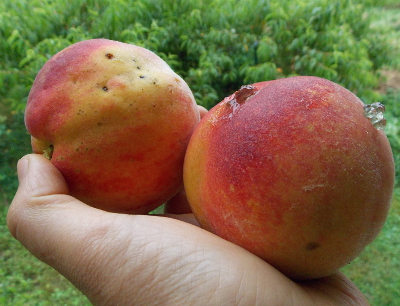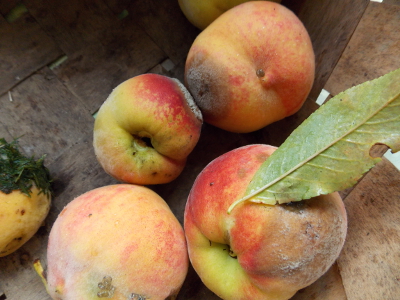
Battling brown rot
 Every time I looked at the
huge, red-blushed peaches on our Redhaven tree last week, I
reminded myself the chances of eating any were slim to none.
We'd seen the sun for about ten hours of that week and had enjoyed
rains at least once a day, so I knew brown rot would set in before the
fruits ripened.
Every time I looked at the
huge, red-blushed peaches on our Redhaven tree last week, I
reminded myself the chances of eating any were slim to none.
We'd seen the sun for about ten hours of that week and had enjoyed
rains at least once a day, so I knew brown rot would set in before the
fruits ripened.
Sure enough, Friday I
noticed a rotting peach in the center of the tree. I removed
it, but by Sunday, five more peaches had come down with the fungal
disease. Unless the weather miraculously stops thinking we
live in a rain forest, I suspect each fruit will succumb as it
builds up enough sugars to feed the fungus.
 In the meantime, I'm
trying out some mitigating measures. The first year we
fought brown rot, I didn't know what it was and wasn't paying
attention, with the result that we basically got no crop.
This time around, I'm using the same techniques I use on other
fungal diseases --- an eagle eye and removal of infected tissue as
quickly as possible. The jury's still out on whether that
will allow at least a few peaches to ripen to perfection on the
tree.
In the meantime, I'm
trying out some mitigating measures. The first year we
fought brown rot, I didn't know what it was and wasn't paying
attention, with the result that we basically got no crop.
This time around, I'm using the same techniques I use on other
fungal diseases --- an eagle eye and removal of infected tissue as
quickly as possible. The jury's still out on whether that
will allow at least a few peaches to ripen to perfection on the
tree.
Meanwhile, I'm also
experimenting with ripening up peaches inside. Granted, I've
read that peaches don't really ripen off the tree, but merely
soften. Still, I suspect they'll be at least as good as
storebought fruit, and will definitely be better than
nothing. The question is whether the brown-rotted fruits
(with the bad spots cut out) will ripen in the fridge, or whether
I need to pick fruits before they're infected. I'm trying a
few of each to see.
Want more in-depth information? Browse through our books.
Or explore more posts by date or by subject.
About us: Anna Hess and Mark Hamilton spent over a decade living self-sufficiently in the mountains of Virginia before moving north to start over from scratch in the foothills of Ohio. They've experimented with permaculture, no-till gardening, trailersteading, home-based microbusinesses and much more, writing about their adventures in both blogs and books.
Want to be notified when new comments are posted on this page? Click on the RSS button after you add a comment to subscribe to the comment feed, or simply check the box beside "email replies to me" while writing your comment.

Anna--In The Orchard, which is about a peach and apple orchard that was revived in the Depression (in Ipswich, MA), the author writes of her spraying the trees with what I guess was a pretty lethal spray. This was before Silent Spring, which came out in the 50s, I think. Anyway, as I was cutting up some Early Transparents (for the applesauce I brought you) I remembered my mother's mother joking that she had to cut out more than she could use of lots of apples. But her point was, that she was able to salvage some... I began to think, well, she had lots of spare time, in her later years, and maybe the modern, sprayed fruit is necessary for our rushed lives today. But then I realized that people have been salvaging parts of apples and peaches for longer than we have used sprays. You know that I salvage what I can of the peaches out back. I isometimes try to hold the ones that are not really ripe, and put them in flat boxes in the "Office" where the flies and wasps won't get them. Ultimately I have to just cut out what is rotten and cook up the rest, into a peach sauce (that can be canned or frozen). Actually, I have frozen pieces of fresh peaches after cutting out the rotten parts. You still could lmake your peach leather, too, out of parts of peaches.
Robert --- I had too much to say for a comment, so I'm going to answer you in a post tomorrow.
Mom --- Great comment! You're totally right that part of the solution is simply rethinking the need for perfection. I cut out blemishes all the time in fruits and vegetables, and even if I lose half of the crop to rot, I've still got half left!